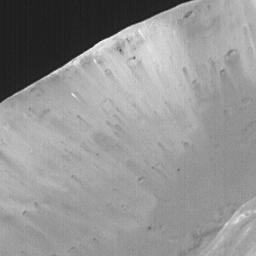
|
High-Resolution MOC Image of Phobos’ Stickney Crater
- Click the image above for a larger view
- Full-Res JPEG (480 x 480) (33.0 kB)
- Full-Res TIFF (480 x 480) (209.2 kB)
Caption:
This image of Phobos, the inner and larger of the two moons of Mars, was taken by the Mars Global Surveyor on August 19, 1998. This image is a close-up of the far wall of the Stickney crater, 10 kilometers (6 miles) in diameter, that is the largest crater on Phobos. This image shows lighter and darker streaks going down the slopes (C). The presence of material of different brightness on the far crater slopes and in some of the grooves shows that the satellite is heterogeneous (that is, it is made of a mixture of different types of materials). The motion of debris down slopes is guided by gravity, which is only about 1/1000th that of the Earth -- e.g., a 68-kilogram (150-pound) person would weigh only about 57 grams (2 ounces) on Phobos. Phobos was observed by both the Mars Orbiter Camera (MOC) and Thermal Emission Spectrometer (TES). This image is one of the highest resolution images (4 meters or 13 feet per picture element or pixel) ever obtained of the Martian satellite.
Background Info:
Malin Space Science Systems, Inc. and the California Institute of Technology built the MOC using spare hardware from the Mars Observer mission. MSSS operates the camera from its facilities in San Diego, CA. The Thermal Emission Spectrometer is operated by Arizona State University and was built by Raytheon Santa Barbara Remote Sensing. The Jet Propulsion Laboratory's Mars Surveyor Operations Project operates the Mars Global Surveyor spacecraft with its industrial partner, Lockheed Martin Astronautics, from facilities in Pasadena, CA and Denver, CO.
Cataloging Keywords:
| Name | Value | Additional Values |
|---|---|---|
| Target | Phobos | Mars |
| System | Mars | |
| Target Type | Satellite | Planet |
| Mission | Mars Global Surveyor (MGS) | |
| Instrument Host | Mars Global Surveyor | |
| Host Type | Orbiter | |
| Instrument | Mars Orbiter Camera (MOC) | |
| Detector | ||
| Extra Keywords | Crater, Dust, Grayscale, Thermal | |
| Acquisition Date | ||
| Release Date | 2000-09-16 | |
| Date in Caption | 1998-08-19 | |
| Image Credit | NASA/JPL/Malin Space Science Systems | |
| Source | photojournal.jpl.nasa.gov/catalog/PIA01335 | |
| Identifier | PIA01335 | |
